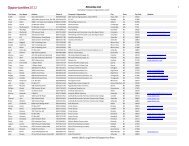Capital Opportunities for Small Businesses - sbtdc
Capital Opportunities for Small Businesses - sbtdc
Capital Opportunities for Small Businesses - sbtdc
You also want an ePaper? Increase the reach of your titles
YUMPU automatically turns print PDFs into web optimized ePapers that Google loves.
C A P I T A L O P P O R T U N I T I E S F O R SMA L L B U S I N E S S E S<br />
CHAPTER 3: FINANCIAL INSTITUTIONS<br />
Commercial Banks<br />
Commercial banks are usually one of the least expensive providers of loan capital and among the largest<br />
sources of credit to small businesses. This source of financing will be most helpful <strong>for</strong> a business that has<br />
demonstrated it can operate profitably. Banks are most interested in financing firms that can show an ability to<br />
repay the loan. This usually means a company must have a strong positive cash flow or assets as collateral that<br />
can be easily liquidated. The evaluation will consist of a detailed analysis of the company’s income statement,<br />
balance sheet, and cash flow statement. Factors such as the content of the business plan and experience of the<br />
management are also considered. If a business has no consistent operating history or cannot demonstrate that<br />
funds will be available to repay the loan, it may be difficult to procure financing using this method.<br />
Payment terms from commercial banks are usually up to five years until maturity but can then be renegotiated<br />
to ten or fifteen years. Most debt is secured, although some unsecured lines may be available. Personal<br />
guarantees are almost always required resulting in exposure of the borrower’s personal assets in the event of a<br />
business failure. Even if the business is <strong>for</strong>med as a corporation, the limited liability feature is superseded by a<br />
personal guarantee.<br />
The interest rate on a loan is typically expressed as a percentage in excess of the prime rate. Prime is the rate<br />
the nation’s largest banks charge their best customers. The prime rate itself will vary according to economic<br />
conditions; it is primarily dependent on the rate the banks themselves are charged by the Federal Reserve to<br />
borrow money. The percentage over prime that a customer is charged is based on the banker’s perception of<br />
the risk taken by granting the loan.<br />
Prime rates can be found at wsj.com/mdc/public/page/2_3020-moneyrate.html.<br />
Lending institutions have different policies towards risk. Some are inclined to follow relatively conservative<br />
lending practices; others engage in more creative banking practices. Banks borrow money elsewhere at a lower<br />
rate and lend it out at a higher rate; there<strong>for</strong>e, the commercial bank’s primary concern is a borrower’s ability to<br />
cover principal and interest repayments. Although bankers are interested in all financial aspects of a borrowing<br />
firm, hard assets provide their primary insurance if the business fails.<br />
According to the SBA Office of Advocacy’s 2013 report on small business lending activities, the total number of<br />
small business loans increased from 21.3 million in June 2011 to 23.5 million In June 2012. The full report is<br />
available at www.sba.gov/advocacy/7540/719311.<br />
The North Carolina Banking Commission currently regulates 108 state-chartered, commercial banks and 24<br />
Trust Companies (or Limited Purpose Banks). Since 1994, the SBA Office of Advocacy has ranked the small<br />
business lending behavior of every commercial bank in each state to help depositors and borrowers identify the<br />
small-business-friendly banks in their state. Four factors are used to rank the small business lending activities of<br />
each bank:<br />
<br />
<br />
<br />
Ratio of small business loans to total assets<br />
Ratio of small business loans to total business loans<br />
Dollar value of small business loans<br />
23









